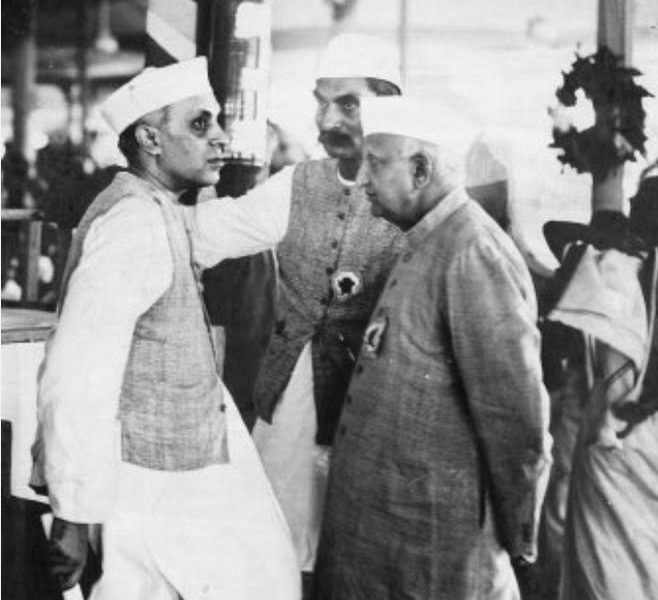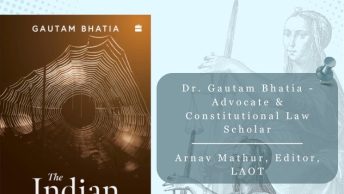Bhulabhai Desai was a towering figure at the Bombay Bar, known for his razor-sharp intellect, eloquence, and mastery of the law, he stood as a symbol of legal brilliance and fearless advocacy. Yet, Bhulabhai was more than just a lawyer; he was a patriot who wielded the law as a weapon against colonial oppression. His masterful defence during the Indian National Army Trials was a defining moment in his illustrious career, where he infused the courtroom with the spirit of India’s fight for freedom, putting colonialism itself on the stand. In the theatre of a public trial at the Red Fort, Bhulabhai was simultaneously constructing a legal defence for INA’s war, manifesting the defiant patriotism of the Indian people, and legitimizing an anticipated armed revolution (Mukherjee 2019). As he told one of the accused, he wasn’t pleading the case before the British court, but before the bar of public opinion and the world (Dhillon 1998).
As we celebrate our 76th Republic Day, this article pieces together the existing literature and serves as a memory of the legacy of Bhulabhai Desai, the significance of the INA Trials in India’s freedom struggle, and one of the first times international law was invoked to defend a colonized people’s right to wage a legitimate war of liberation.
The Context and the Charge
In 1942, following the British Indian Army’s surrender to Japanese forces in Singapore during World War II, the Indian soldiers were presented with a choice: remain prisoners of war or join the INA. Around 25,000 soldiers chose the latter, and under the leadership of Mohan Singh and later Subhas Chandra Bose, the INA formed the Ārẓī Ḥukūmat-e-Āzād Hind (Provisional Government of Free India) and declared war against the British Empire. Despite their valiant efforts, in 1944-45, the INA were defeated, with key losses in Imphal and Kohima. (Fay 1993)
In the aftermath, seeking to reinforce military discipline and deter further dissent, the British court-martialled three key officers – Shah Nawaz Khan, Prem Sahgal, and Gurbakhsh Singh Dhillon – in a public and highly symbolic trial chaired by Commander-in-Chief Claude Auchinleck. Led by the Advocate General Sir Naushirwan Engineer, the prosecution argued that the King’s sovereignty over Indian subjects was absolute, rendering the INA and the Provisional Government of Free India inherently illegal. It accused the defendants of coercing prisoners of war to join the INA and abetting violence against those who resisted, framing them as individuals guilty of treason under the Indian Army Act 1911 and Indian Penal Code 1860. (Noorani 2005)
Interestingly, efforts by British wartime censors had left the rest of the country in the dark on news relating to the INA. As a result, Naushirwan faced a significant tactical problem in presenting evidence of the existence of the INA. Between 5th November – 31st December 1945, the prosecution rigorously and meticulously presented witness reports, intelligence summaries, intercepted communications, and other evidence, through which Naushirwan transformed what had been a ghost army, a chimera, into a real thing (Sellars 2015).
Defying Empire and Defending Sovereignty
With the country watching, the prosecution’s evidence revealed that Indians had formed a tens-of-thousands-strong army, led by their own officers, which had fought and occasionally defeated the British. This had an electrifying effect on the Indian people. The trial itself, held anywhere, would have ignited public opinion; more so in the Red Fort. Even the charge, of ‘waging war against the King-Emperor’ is aptly described by Noorani: ‘no phrase could have held less political opprobrium among Indians in 1945, or echoed more succinctly the note of imperial discipline which political India believed was now fading to a whisper’ (Noorani 2005).
In this charged environment, Chief Defence Counsel Bhulabhai Desai delivered a two-day speech without any notes (on a side note, see Chagla 1973 on Bhulabhai having never made a single note throughout his career, following Inverarity’s advice to “trust your memory”). Bhulabhai first relied on Section 79 of the IPC which states that ‘Nothing is an offence which is done by any person who… believes himself to be justified by law, in doing it’ and used Shah Nawaz Khan’s testimony that when forced to choose between King and country, ‘I decided to be loyal to my country’ to show the accused’s belief that their cause was just. But what made the INA Trial unlike any political trial of the past, was the invocation of international law to assert the right of the Indian people to wage a violent struggle for national independence.
Before the 20th century, international law only recognized sovereign and independent states as having the right to declare or wage war, excluding colonized nations. This, Bhulabhai argued, perpetuated a vicious cycle of subjugation, where ‘a subject race will remain in perpetuity a subject race’ (INA Defence, p.28). However, he contended, modern international law had evolved to acknowledge the legitimacy of wars of national liberation: “And it will be travesty of justice if we were to be told as a result of any decision arrived at here or otherwise, that the Indian may go as solider and fight for the freedom of England against Germany, for England against Italy, for England against Japan, and yet a stage may not be reached when a free Indian State may not wish to free itself from any country, including England itself.” (INA Defence, p.27)
Bhulabhai’s arguments rested on two limbs. Contrary to the prosecution’s claims that it was just a Japanese-run fifth column, he argued that the INA was a legitimate, self-governing force, with its own ranks and regalia, having the goal of liberating India (INA Defence). Further, he argued that the Provisional Government of Free India met the criteria of statehood as it possessed its own territory (including the Andaman and Nicobar Islands ceded by Japan), control over a population (in East Asia and North East India) and recognition by Japan, Burma, Croatia, Manchukuo, Siam and others. This government had then declared war on Britain, thereby assuming the rights of a belligerent state under international law, making the soldiers entitled to be treated as belligerents rather than criminals (see Lauterpacht 1947 on recognition in international law).
Bhulabhai highlighted the hypocrisy of Britain recognizing European liberation movements during World War II while dismissing the INA’s legitimacy. He compared the INA’s struggle to the American War of Independence, invoking the right to overthrow unjust governments. Questioning the monopoly that European imperial powers claimed on legitimate war, Bhulabhai asserted that wars fought for self-determination, like the INA’s campaign, were moral and just, thus challenging the Eurocentric foundations of international law, which upheld imperial wars while criminalizing anticolonial resistance (see Mukherjee 2019).
Impact on Independence and International Law
Through his defence at the Red Fort, Bhulabhai redeemed in discourse a war that had been defeated on the ground (Mukherjee 2019). As historian Michael Edwards (1963) dramatically put it, ‘The ghost of Subhas Bose, like Hamlet’s father, walked the battlements of the Red Fort, and his suddenly amplified figure over-awed the conferences that were to lead to independence’. Bhulabhai reframed the trial as not about treason but about the fundamental right of a colonized people to wage war for their freedom. His arguments challenged the supremacy of domestic security laws but ultimately failed to sway the court. On 31 December 1945, all three INA officers were convicted of waging war against the King, though their sentences were later commuted.
Despite the verdict, Bhulabhai’s defence profoundly influenced India’s independence movement. At a rally soon after, Nehru claimed that the INA Trial took India ‘many steps forward on our path to freedom. Never before in Indian history had such unified sentiments and feelings been manifested by various divergent sections of the Indian population as it has been done with regard to the question of the Azad Hind Fauz’ (Noorani 2005). As the trial ended, an unprecedented wave of unrest engulfed India, marked by widespread mutinous discontent within the Royal Indian Navy, segments of the British Indian Army, and the Royal Indian Air Force, alongside massive public protests against colonial rule. The naval mutiny of 1946, in particular, struck at the core of British authority, signalling the erosion of loyalty within the armed forces and galvanizing the independence movement by demonstrating that even key pillars of imperial control were no longer unshakable (Sharma 2015). The trial and subsequent public outrage was the ‘ proverbial straw that broke the camel’s back of colonial rule in India ‘ (Wangchuk 2020).
Bhulabhai’s arguments justifying a war for national liberation have also influenced the course of international law. Justice Radhabinod Pal, dissenting at the Tokyo War Crimes Tribunal, drew attention to American chief prosecutor Robert Jackson’s argument at the Nuremberg Trials that, ‘whatever grievances a nation may have, however objectionable it finds the status quo, aggressive warfare is an illegal means for settling those grievances or for altering those conditions’ (Nuremberg Trials 1945). Echoing Bhulabhai’s critique of colonialism, Pal held that a call for the paralysis of international affairs, and by implication the criminalisation of the struggle against colonialism was too high a price to pay for mere security as dominated nations ‘cannot be made to submit to eternal domination only in the name of peace’ (Pritchard 1998).
Despite the INA trials’ importance in India’s decolonization, they have received little attention from legal and political historians. This neglect stems in part from prevailing narratives about Indian independence. The nationalist view credits Gandhi’s nonviolent resistance and the Indian National Congress almost exclusively (see Sitaramayya 1946), while the imperial narrative frames Britain’s withdrawal as a benevolent ‘transfer of power,’ (see Seal 1968) downplaying the significance of armed resistance (see Mukherjee 2019 on dominant historiographical narratives and literature gap surrounding INA trials).
Described as ‘the lawyer who argued India her freedom’ (Ghose 2020), Bhulabhai’s legacy extends beyond the courtroom. His arguments reframed the INA’s actions as a moral and legal fight for independence, uniting a nation and weakening British control. Not only did he influence India’s freedom struggle but also contributed to the evolving discourse on international law. The INA trials occurred as the Eurocentric foundations of international law were being challenged (Schmitt 2003). Bhulabhai’s defence exposed how international law reinforced imperial dominance, advocating instead for a new framework based on equality among nations in a post-imperial world.
Further Reading
1. A complete record of the INA Trials including the order constituting court martial, charge sheet, counsels involved and the defence address by Bhulabhai Desai published by the INA Defence Committee in 1954 can be accessed here. It has also been captured in Moti Ram, Two Historic Trials In Red Fort (1946), with a foreword by Jawaharlal Nehru.
2. M.C. Setalvad, India’s first and longest-serving Attorney General, began his legal career attending Bhulabhai’s chambers in 1912. Setalvad wrote a biography of Bhulabhai Desai (1968) which can be accessed here. Additionally, Setalvad’s biography ‘My Life – Law and Other Things’ contains interesting insights into Bhulabhai.
3. For an understanding of political trials in India generally, and the social and political milieu in which the INA Trial took place, see A.G. Noorani, Indian Political Trials 1775-1947 p.265-285 (Oxford University Press, 2005).
4. For a discussion comparing treason trials around the world, and Bhulabhai’s unique approach in the INA Trials challenging the very premise of treason and reframing the issue as one of the legitimacy of wars for national liberation, see Kristen Sellars, Treasonable conspiracies at Paris, Moscow and Delhi: The legal hinterland of the Tokyo Tribunal (Cambridge University Press, 2015).
5. For an in-depth discussion on the contribution of the INA Trials to the development of international law on the right of a colonized people to wage war for liberation, see Mithi Mukherjee, The “Right to Wage War” against Empire: Anticolonialism and the Challenge to International Law in the Indian National Army Trial of 1945 (Cambridge University Press, 2019).
6. For a detailed examination of the role of the INA in the independence movement, see Peter Ward Fay, The Forgotten Army: India’s Armed Struggle For Independence 1942-1945 (University of Michigan Press, 1993).
Eeshan Sonak is an Associate at Shardul Amarchand Mangaldas, practicing primarily at the Bombay High Court
[Ed Note: This piece was edited by Thejalakshmi Anil and published by Baibhav Mishra of the Student Editorial Team. The author would like to thank Vikram Raghavan and Vishwajeet Deshmukh for their valuable suggestions on an earlier draft of the piece.]







xo59e5
zvij5b
OTShpD4e3av